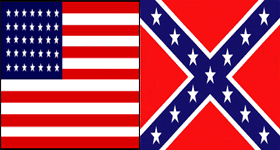 |
Civil War Battles |
|
State War Records |
| AL - AK - AZ - AR - CA - CO - CT - DE - FL - GA - HI - ID - IL - IN - IA - KS - KY - LA - MA - MD - ME - MI - MN - MS - MO - MT - NE - NV - NH - NJ - NM - NY - NC - ND - OH - OK - OR - PA - RI - SC - SD - TN - TX - UT - VT - VA - WA - WV - WI - WY |
The Battle of Guard Hill
August 16, 1864 in Warren County, Virginia (aka Battle of Crooked Run)
 |
|||||||||||||||||||||
|
With the Army of the Potomac too strong for Gen. Robert E. Lee to attack, he had to seek offensive opportunities elsewhere. In mid-summer the best option was in the Shenandoah Valley, where Gen. Jubal A. Early had almost repeated Gen. Thomas J. "Stonewall" Jackson’s exploits. Although Early had been rebuffed at Washington, he still had a potent force in the Valley.
On August 7th, Maj. Gen. Philip H. Sheridan assumed command of the Union forces in the Shenandoah Valley. Three days later, his army advanced southward up the valley against Early. The outnumbered Confederates withdrew to the strong, natural defensive position at Fisher's Hill, where the 2 armies, constantly skirmishing, stalked each other for 4 days.
When Sheridan advanced, Early urgently requested reinforcements from Richmond. Lee responded by sending an infantry and a cavalry division and an artillery battalion, all commanded by Lt. Gen. Richard H. Anderson. By the afternoon of the 14th, Anderson's command had reached Front Royal at the northern end of the Luray Valley, where the north and south forks of the Shenandoah River meet. The Confederate reinforcements threatened Sheridan's left, rear, and communications.
Sheridan ordered Brig. Gen. Wesley Merritt's cavalry division toward Front Royal. On the 15th, Merritt's pickets guarded the roads leading from Front Royal to the Union rear. Anderson responded to the presence of the Union cavalry by sending Brig. Gen. William T. Wofford's infantry brigade and Brig. Gen. Williams C. Wickham's cavalry brigade across the Shenandoah River to Guard Hill to cover the fords.
About afternoon on the 16th, Wickham charged the advance videttes of Brig. Gen. Thomas C. Devin's brigade at Cedarville. Devin rapidly brought forward 2 regiments, which counterattacked down the road. A Confederate and an Union regiment crashed together in a swirling fight with sabers. The Confederates broke, falling back on their reserves. Wickham personally led another charge that blunted the Union drive until his troopers recrossed the river. Devin's cavalry had seized 2 flags and 139 prisoners and horses.
Wofford, meanwhile, held Guard Hill, coming under attack from Brig. Gen. George A. Custer's brigade. Custer's 5th Michigan, armed with Spencer repeaters, shoved the Confederate infantry off the hill. Wofford's troops quickly streamed toward the river, where many of them drowned or were helplessly shot by the Union cavalry. The Union victory had been sharp and decisive.
Merritt's confirmation of the presence of Confederate infantry, cavalry, and artillery at Front Royal forced Sheridan to order a withdrawal down the valley.
That night the Federals began retreating back to their lines at Harper's Ferry. After dark, Merritt withdrew to Ninevah.
